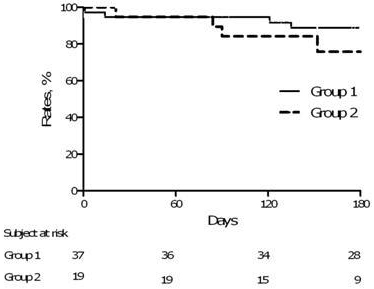| єя«•«ьљƒ : ±Єњђ
|
ЅҐЉцєш»£ - 550547 323 |
| Optimal revascularization for infrapopliteal arteries disease with Critical Limb Ischemia: a real-world experience. |
| мДЬмЪЄмХДмВ∞л≥СмЫР мИЬнЩШкЄ∞лВік≥Љ |
| нЩ©кЄ∞мЫР, мЭімҐЕмШБ, кєАмЪ©кЈ†, л∞Хк≤љлѓЉ,кґМм∞љнЭђ, мЮ•м†ХмЬ§, мµЬмДЭмЫР, мЖ°нШЬкЈЉ, мХИм†ХлѓЉ, кєАмЫРмЮ•, л∞ХлНХмЪ∞, к∞ХмИШмІД, мЭімКєнЩШ, кєАмШБнХЩ, мЭім≤†нЩШ, л∞ХмД±мЪ±, л∞ХмКєм†Х |
Background – Little is known about the optimal limb salvage strategies using infrapopliteal intervention patients with critical limb ischemia (CLI) in current recommendations. We tried to investigate clinical impacts of optimal revascularization of infrapopliteal arteries in patients with CLI.
Methods – Between January 2008 to December 2010, a total of 56 lesions in 51 patients having CLI due to triple infrapopliteal arteries disease were successfully treated by the endovascular therapy and enrolled in the current analysis. According to treatment strategies, study population was classified into two groups: restoring straight-line flow to the foot revascularization (group 1, n=37), or both complete revascularization–defined as both anterior and posterior arteries with or without peroneal artery (group 2, n=19). Primary outcome was the amputation or repeat revascularization-free survival at 6 months.
Results РBaseline characteristics were not different between groups. The mean age was 69.8 ± 8.4. Diabetic disease was noted in 51 (91.1%) of the treated limbs at the time of the procedure. There were 1 aorto-iliac lesion and 27 limbs femoro-popliteal lesions during infrapopliteal intervention. At 6 months, the incidence of primary outcome was not significantly different between groups (85.5% and 78.9%, p=0.415). At 6 months, 2 patients died of aspiration pneumonia, but were not related to the procedure. For the individual clinical outcomes, repeat revascularization rate at 6 months was 10.8% in the group 1 vs. 10.5% in the group 2 (p= 0.891). Major 3 amputations were performed(1 limb vs. 2 limbs, p=0.231). Complete revascularization was not significant predictor of primary endpoint by Cox multiple regression analysis (HR 1.43; 95% CI 0.20-10.21, p=0.723).
Conclusion – Our study shows that minimal procedure for restoring straight-line flow to the foot revascularization is efficient therapeutic modality for limb salvage strategies as complete revascularization in triple infrapopliteal arteries disease with CLI.
|
|
|
Warning: getimagesize(/home/virtual/circulationadmin/renewal/econgress/conference/abstract/img_files/fig_550547.jpg) [function.getimagesize]: failed to open stream: No such file or directory in /home/virtual/circulationadmin/new/econgress/conference/manage/schedule/view_abstract.php on line 164

|
|





